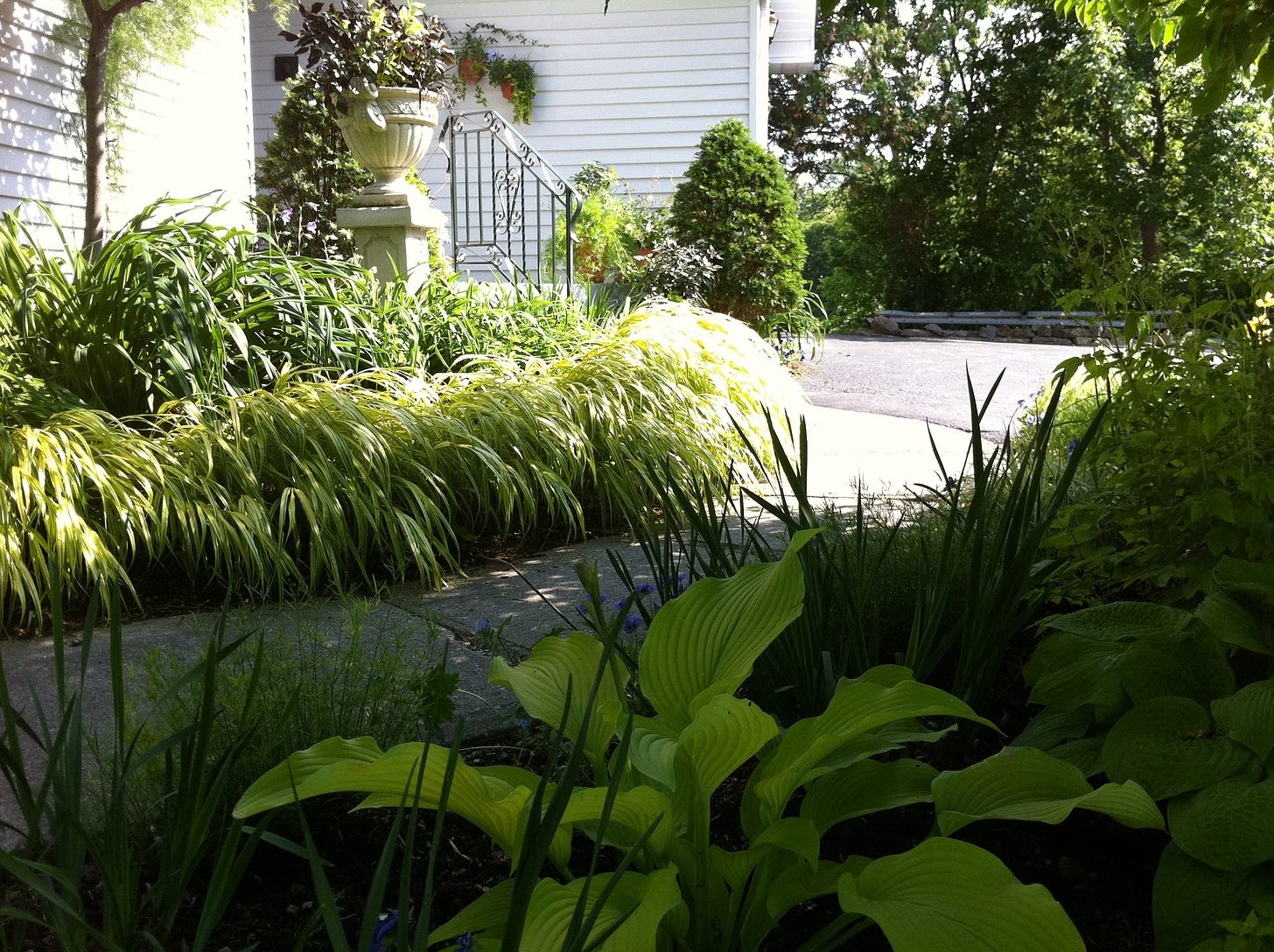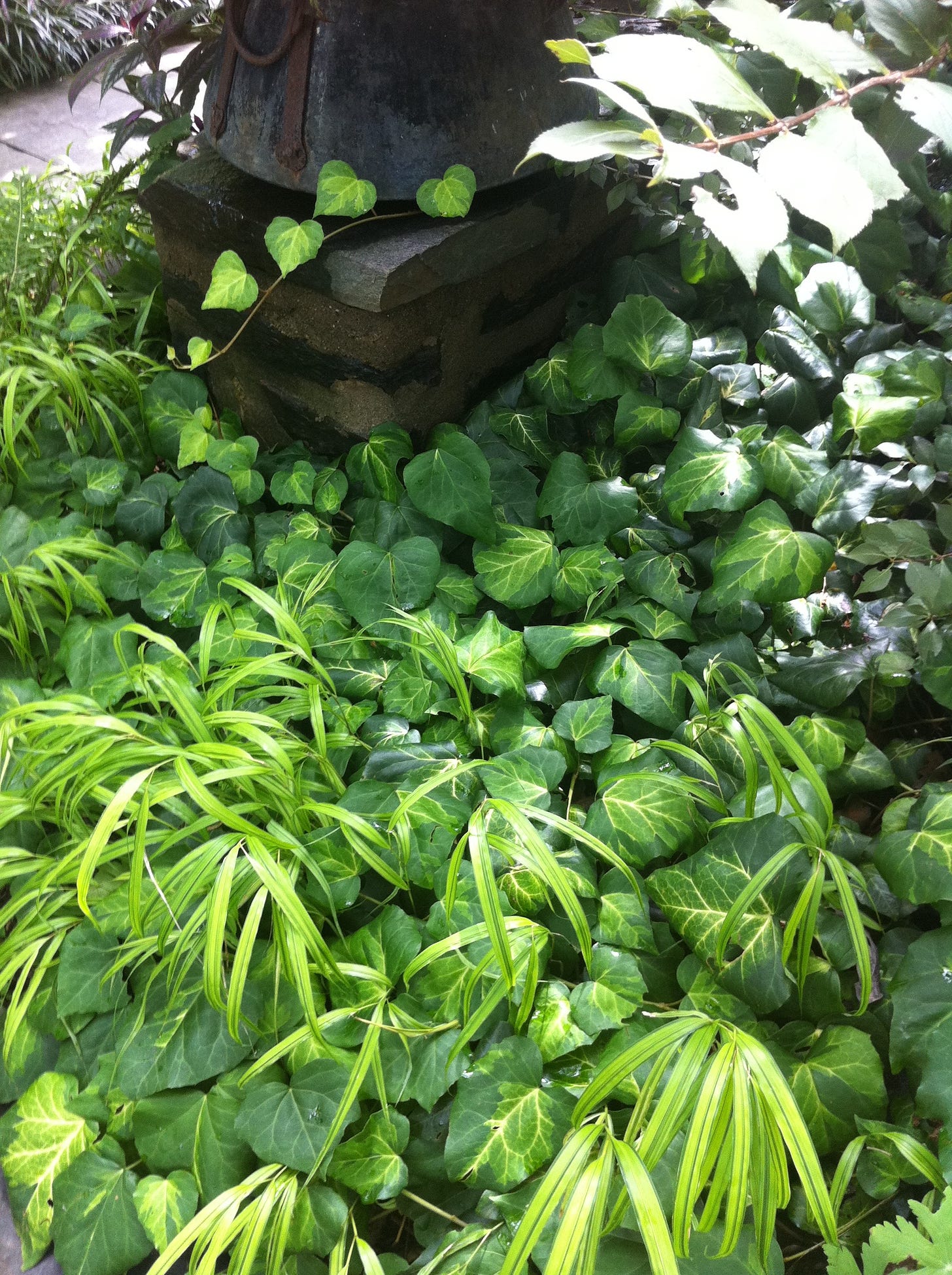How do we create a garden tapestry, Part II
Ground covers or covering ground?
I had started this post thinking I was writing about groundcovers, but it seems to have veered in the direction of covering ground instead. That is, plants that are not necessarily low growing, but nevertheless create a covering.
I remember visiting Les Jardins de Quatres-Vents where the very wealthy and well connected Francis Cabot had created a series of spectacular garden conceits. He delighted in creating different garden fancies, using the most choice, rare and extravagant plants and materials.
In the surprise of a cool dell, the visitor stumbles upon this mass planting of Himalayan blue poppies, which are notoriously hard to grow where the temperatures are not continuously cool and the atmosphere humid. In an effort to ensure this environment, Francis installed a vast sprinkler system that sprays cooling mist over the area, keeping the plants happy and robust.
But of course, we do not have the luxury of unlimited funds and the folly to use them in such a way. Don’t get me wrong; I was delighted to see this display but I was also aware that the gardens were a contrivance…but that was another blog post.
A garden tapestry uses the concept of repetition and rhythm to knit a planting together. In this shade garden belonging to the inspired Margaret Roach, European wild ginger (Asarum europaeum) is used as a groundcover to sweep across the edge of this garden bed. It binds together a planting that includes Japanese painted fern (Athyrium niponicum), celandine poppy (Stylophorum diphyllum), shieldleaf Rodgersia (Astilboides tabularis) and hosta, among others. It is the perfect perennial to do this, with its densely packed shiny green leaves and low profile. And it provides a striking contrast to its well-chosen companions, with their silvery metallic, giant or cutleaf foliage.
This close-up tapestry is from my now-prior small city garden, where plants had to survive a mostly shaded spot, with some sun at the end of the day. The spectacularly blue ‘Halcyon’ hosta sits behind a spotted lungwort (Pulmonaria) and the bronze eye-lined leaves of the most excellent barrenwort (Epimedium).
It is important that plants with such a pivotal role in your compositions are excellent all-season performers and don’t need coddling. Of these three, lungwort will likely need it’s blooming stems removed after the flowers are finished but if the soil has been kept moist and fertile, they likely won’t need any more serious cutting back.
Golden Hakone or Japanese forest grass (Hakonechloa macra ‘All Gold’) is a spectacular plant with which you can cover ground. It remains delicate and bright and full of movement for the entire growing season and successive plants blend into one another, creating a wave. They are the perfect edge to a path…or grown, as below, in pockets, providing visual continuity.
…but they are also the perfect foil for a broader leafed plant — here paired beautifully with this Algerian ivy (Hedera canariensis), its green broken with splashes of gold, emphasizing the veining — a spectacularly sensitive combination.
I’ll end with this gorgeous eye-full! It was a section of planting in one of the entrance patios at Chanticleer, a gardeners’ and plant lover’s paradise just outside Philadelphia. ‘Matrona’ sedum is the tie-in here, melding the purple of what is likely Red Shiso (Perilla frutescens) and perhaps a sprawling ninebark (Physocarpus) and purple smokebush (Cotinus coggygria) with the green of the supporting actor plants. What a pleasure it was to look down and see this as we entered this world-class garden! It certainly gave us a taste of what was to come…
Forgive me for being all over the place here. I think the excitement of a new year and this new project has wreaked havoc on my organizational abilities …. nevertheless, I’ll be back again soon with another series of thoughts on I-don’t-know-what-yet!








Beautiful photos and great descriptions! Thanks to your post, I now have some new ideas for our north bed which is in need of some plants to weave around other plantings and cover the ground. We have a hosta there and some dark-leaved heuchera along with a columbine that likes the shade. Our area also supports growing hellebores and we have 5 of them. I don't dare look at the selection our nursery offers or I will buy some more. :-)
I am thinking one of the epimediums might be a good choice to weave around the plants. I checked the online catalog for our fantastic local nursery, Fraser's Thimble Farms, and they have a huge selection. It might be hard to choose - although the rubrum and the perralchicum looked very appealing. Hmmm... lots to think about. Thanks!